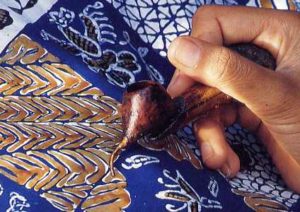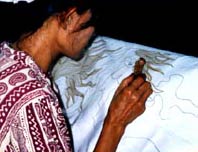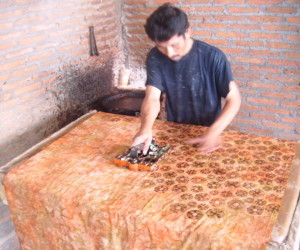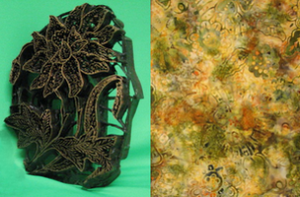What are Batiks?

Batik is the process of waxing and dyeing cloth. Hand drawn batiks, which are called Tulis Batiks, are examples of the finest batik work. Their designs are drawn or painted in wax by hand with a tool known as the canting (see photo to the right). The canting consists of a small copper cup with a spout through which melted wax can flow out onto the cloth. The cup is mounted on a wooden or rattan handle. The size of the spout and the number of spouts may vary for different functions. To begin making a tulis batik, beeswax is melted in a small metal pot with a flame underneath. The design is drawn on the cotton fabric with a pencil. The cloth is tacked onto a wooden frame. Then taking the canting tool, the artist dips into the melted wax and begins applying it to the cloth.

Once they have outlined the design, they pour on the first dye. Then the artist applies the second coat of wax, painting with wax the areas to be saved. They start with the lightest colors working toward the darkest colors waxing the front and back and the front again for each new dye color used. When they are finished with this process, they put the fabric in boiling water and melt the wax off.
Batik originated centuries ago in what are now the countries of Maylasia and Indonesia. The promotion of the village arts is a way of keeping alive an important part of a vibrant and beautiful culture. That is why I go directly to the Javanese villages and buy the batik directly from the artists. They use 100% cotton cloth. All dyes used are colorfast.
The Batik Art Paintings provide quilters, craft and home sewers, and interior designers with an opportunity to combine an ancient art form with a contemporary use. Each Batik Art Painting is handmade individually, the colors and designs may vary.

Batik Fabrics are basically the same process, except the fabric is dyed in lengths of 10 to 20 yards. The artists use handcrafted metal stamps to create the motif on the fabrics. The stamps are dipped in wax and applied to the fabric, instead of drawing with the wax with the canting tool, as with Batik Art Paintings.
Batik Care
All dyes used in the Batik Paintings and Fabrics are colorfast. Some residual wax may remain on the Batik. In this case, wash the area in warm sudsy water to remove the excess wax. The Batiks can be washed and dried in a machine. To remove wrinkles, iron hot with steam and spray. The Rayon and Knit Batik fabrics must be pre-washed and dried before use as they shrink up to 3″ per yard. Allow for this shrinkage when making your purchase.
